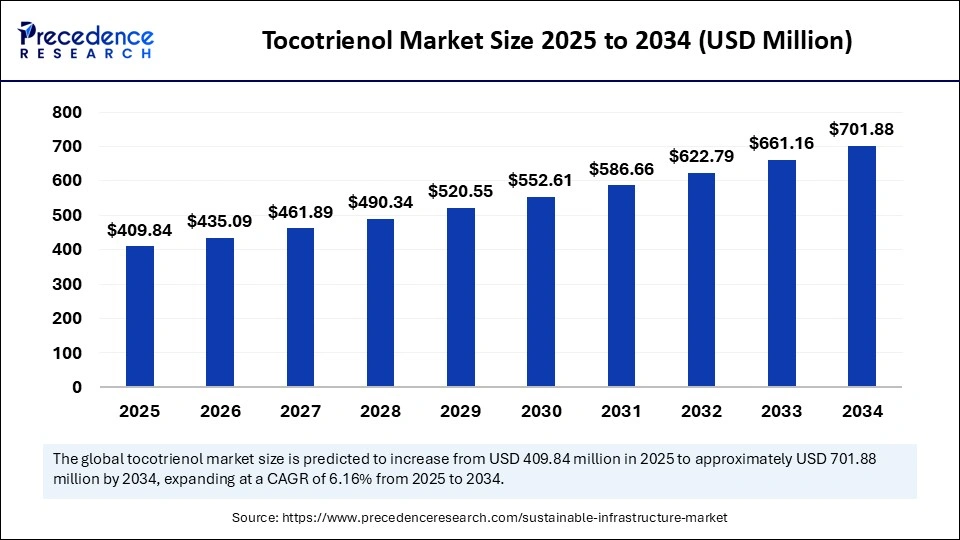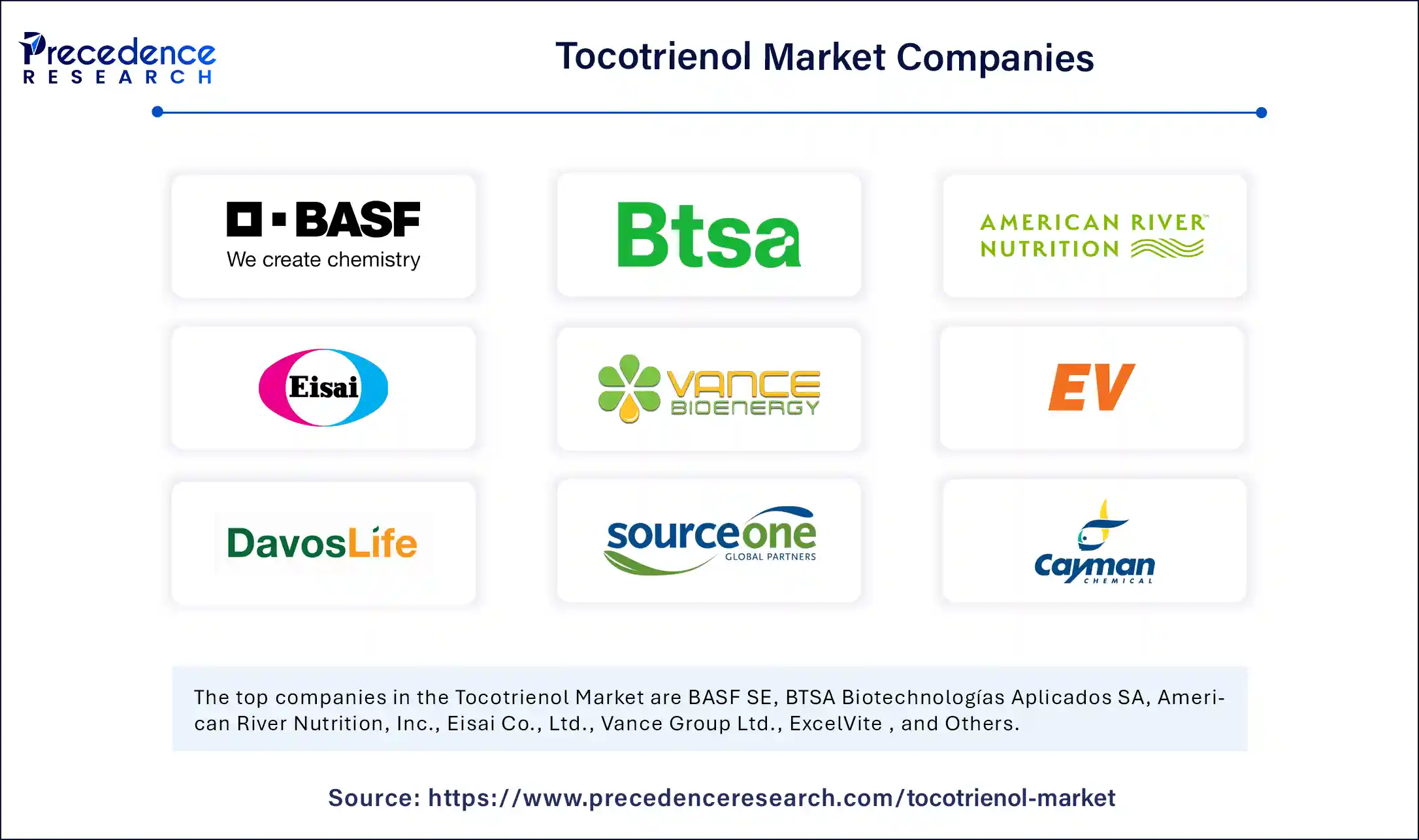
Market Overview
The Tocotrienol Market refers to the global trade, production, and consumption of tocotrienols, which are members of the vitamin E family with distinct chemical structures that confer potent antioxidant, anti‑inflammatory, and neuroprotective properties. Unlike tocopherols, tocotrienols have unsaturated side chains that allow them to penetrate more effectively into cell membranes, enhancing their biological efficacy.
The Tocotrienol Market is segmented by source (palm oil, annatto, rice bran, etc.), by isomer type (alpha, beta, gamma, delta), by application (dietary supplements, cosmetics, pharmaceuticals, functional foods), and by geography. In recent years, the market has been growing steadily, spurred by increasing health awareness, aging demographics, and demand for natural ingredients. Forecasts suggest a compound annual growth rate (CAGR) in the range of 6‑9% over the next 5 to 10 years, with the market size moving from a few hundred million USD to nearly a billion USD in some analyses. Natural tocotrienols lead the market share over synthetic forms because consumers prefer clean‑label, plant‑based sources.
AI and Innovation
Innovation is playing a critical role in redefining the Tocotrienol Market. Advances in extraction and purification techniques are reducing costs and increasing yield. Companies are investing in novel delivery systems—such as nanoemulsions, liposomes, and beadlet technologies—to enhance bioavailability and stability of tocotrienols in formulations. Artificial Intelligence (AI) is increasingly being used to optimize extraction parameters, model degradation kinetics, and accelerate product formulation.
AI‐based predictive analytics helps researchers forecast market demand, anticipate regulatory changes, and design personalized tocotrienol blends for specific consumer segments (e.g. for cardiovascular health, skin health, or cognitive aging). Innovation also manifests in combining tocotrienols with other bioactives (co‑formulations) and exploring sustainable raw material sources (e.g., annatto, rice bran) to reduce dependence on palm oil and improve environmental credentials.
Future Trends of Market
Looking ahead, several trends are shaping the future of the Tocotrienol Market. First, the integration of tocotrienols into functional foods and beverages is expected to expand. Fortified snacks, energy bars, and drinks with tocotrienols will become more common as consumers seek wellness foods rather than just dietary supplements. Second, nutricosmetics (beauty from within) will drive demand: formulations combining skin health, anti‑aging, and antioxidant protection will increasingly use tocotrienols. Third, customized nutrition and personalized wellness will grow: products tailored to genomic profiles, age groups, or chronic disease risk may feature tocotrienols as key ingredients.
Fourth, sustainability and traceability will be more central: consumers, especially in developed markets, will demand proof of responsible sourcing and minimal environmental impact in the Tocotrienol Market supply chain. Fifth, regulatory clarity and clinical research will expand: more human trials will provide strong evidence of efficacy, unlocking therapeutic claims and possibly pharmaceutical applications.
Rising Demands of Market
The demand underlying the Tocotrienol Market is rising for several reasons. Public awareness of chronic diseases—such as cardiovascular disease, neurodegenerative diseases, diabetes, and obesity—is pushing consumers to preventive health solutions. The antioxidant and anti‑lipidemic properties of tocotrienols are attracting attention among those seeking to address cholesterol, oxidative stress, and inflammation. In the skincare and beauty industries, rising demand for natural anti‑aging ingredients is boosting tocotrienol usage.
Also, the aging population globally is a strong driver: older consumers are more interested in cognitive resilience, bone health, and mitigation of age‑related decline. Growing middle classes in Asia, Latin America, and the Middle East are increasing their spending on wellness, supplements, and premium cosmetics. E‑commerce channels and health & wellness retail are making tocotrienol products more accessible, which amplifies demand.
Key Market Highlights
Some of the key highlights in the Tocotrienol Market include:
-
Product innovation: Several companies have launched tocotrienol blends with higher purity, special isomer profiles (e.g. delta dominance), or enhanced bioavailability.
-
New application areas: Beyond traditional supplements, tocotrienols are being explored for animal feed, functional foods, cosmeceuticals, and even pharmaceuticals.
-
Regulatory activity: Increased regulatory support in certain regions for natural antioxidant claims, and emerging guidelines for safety and health claims involving tocotrienols.
-
Strategic partnerships and mergers: Ingredient suppliers are forming alliances to scale up production, improve quality control, and secure sustainable raw material sources.
-
Sustainability and sourcing: Efforts are underway to ensure tocotrienol raw materials are sourced sustainably (for example palm oil certification, alternative plant sources) to meet consumer expectations and regulatory demands.
Market Growth Drivers
Several forces are driving growth in the Tocotrienol Market:
-
Health consciousness and preventive care: As consumers increasingly prioritize wellness over cure, ingredients with clinical backing—such as tocotrienols—gain preference.
-
Scientific evidence and clinical studies: Growing volume of research showing benefits of tocotrienols in heart health, neuroprotection, inflammation control, etc. This helps build trust and justify higher price points.
-
Rising disposable incomes and urbanization: Especially in emerging economies, more people can afford premium health and beauty products, including tocotrienol‑based formulations.
-
Cleaner label and natural / plant‑based products trend: Preference for natural sources over synthetic, less processed, non‑GMO etc. makes natural tocotrienols more attractive.
-
Advances in delivery technology: Better formulations that enhance bioavailability, stability, taste, etc., allowing tocotrienols to be used in more types of products.
Also Read@ https://www.pharma-geek.com/dehydration-monitoring-devices-market/
Restraints
Despite the positive outlook, several restraints limit the speed and reach of the Tocotrienol Market:
-
Production cost and raw material supply: Extracting high‑purity tocotrienols is expensive; palm oil supply issues, environmental concerns, and competition for raw material all contribute.
-
Regulatory hurdles: In many jurisdictions, health claims are strict; clinical evidence required is high; approvals may take time. Also, differences in regulation across countries can complicate global marketing.
-
Limited consumer awareness: In some developing regions, consumers don’t yet know what tocotrienols are, or how they differ from standard vitamin E / tocopherols; hence adoption is slow.
-
Competition with alternative antioxidants and vitamin E forms: Tocopherols, synthetic vitamin E, other natural antioxidants may be cheaper or more familiar, so they pose substitution risks.
-
Stability, bioavailability challenges: Tocotrienols may degrade, or lose effectiveness if not properly formulated or delivered; technological complexity adds cost.
Opportunities
The Tocotrienol Market has rich opportunities ahead:
-
New geographic markets: Countries with rising incomes in Asia‑Pacific, Latin America, Africa represent growth zones where awareness is increasing but market is not yet saturated.
-
Functional foods and beverages: Incorporating tocotrienols into everyday consumables like drinks, cereals, snack bars to reach broader consumer base.
-
Cosmeceutical and nutricosmetic growth: Skin, hair, anti‑aging, UV‑protection products infused with tocotrienols offer premium price potential.
-
Diagnostic‑driven personalized nutrition: Tailoring formulations based on biomarkers or genetic profiles could allow more precise use of tocotrienols.
-
Sustainable sourcing and transparency: Companies that can ensure traceability, minimize environmental impact, use alternative sources, may gain competitive advantage.
Regional Insights
The performance of the Tocotrienol Market varies greatly across regions:
-
North America: High awareness, regulatory structure and strong demand for dietary supplements and cosmeceutical applications. Consumers are willing to pay premium for proven health benefits. The United States leads, followed by Canada.
-
Europe: Growing interest in functional foods, organic/natural products, sustainability, plus stringent regulation that ensures quality. EU countries tend to demand strong clinical evidence for claims.
-
Asia‑Pacific: Likely the fastest‑growing region. Driven by large population bases (e.g. India, China, Southeast Asia), rising incomes, increasing health awareness, and access to raw materials (palm oil, rice bran). Also, governments may support nutraceutical and natural health industries.
-
Latin America: Moderate growth; increasing consumer interest in health and beauty, rising disposable incomes, but also price sensitivity and less regulatory clarity in some countries.
-
Middle East & Africa: Emerging demand mostly in premium cosmetics and wellness segments; import dependence high; market growth tied to increasing urbanization, rising incomes, and growing awareness.
Tocotrienol Market Companies

- BASF SE
- BTSA Biotechnologías Aplicados SA
- American River Nutrition, Inc.
- Eisai Co., Ltd.
- Vance Group Ltd.
- ExcelVite
- Davos Life Science
- SourceOne Global Partners
- Cayman Chemical
- Orochem Technologies Inc.
- A.C. Grace Company
- Parchem
- Sime Darby Oils Nutrition.
- Supervitamins Sdn. Bhd.
- SOP Nutraceuticals
Get Free Sample Link @ https://www.precedenceresearch.com/sample/6750
- Digestive Diamine Oxidase Enzyme for Supplements Market Size to Reach USD 43.87 Mn by 2034 - September 11, 2025
- Tocotrienol Market Size to Reach USD 701.88 Million by 2034 - September 11, 2025
- Wearable Biometric Monitor Market Size to Reach USD 25.26 Billion by 2034 - September 10, 2025
